FIN200: Capital Budgeting Techniques for Decision Making Report
VerifiedAdded on 2019/11/19
|13
|2685
|268
Report
AI Summary
This report provides an in-depth analysis of capital budgeting techniques and their application in the decision-making process, using Woolworths as a case study. It explores the importance of capital budgeting, emphasizing the use of sensitivity analysis, scenario analysis, break-even analysis, and simulation techniques. The report details the decision-making process, highlighting the limitations of traditional methods like net present value and internal rate of return when assessing project viability. It explains each analytical technique, including their methodologies and benefits, to aid financial managers in evaluating investment projects. The report concludes that scenario and simulation analysis are superior budgeting procedures, especially the latter, which utilizes computer-based simulations to handle complex variables. The report underscores the significance of these tools in mitigating risks and making informed investment decisions.

FIN200 Assignment
Paraphrase This Document
Need a fresh take? Get an instant paraphrase of this document with our AI Paraphraser
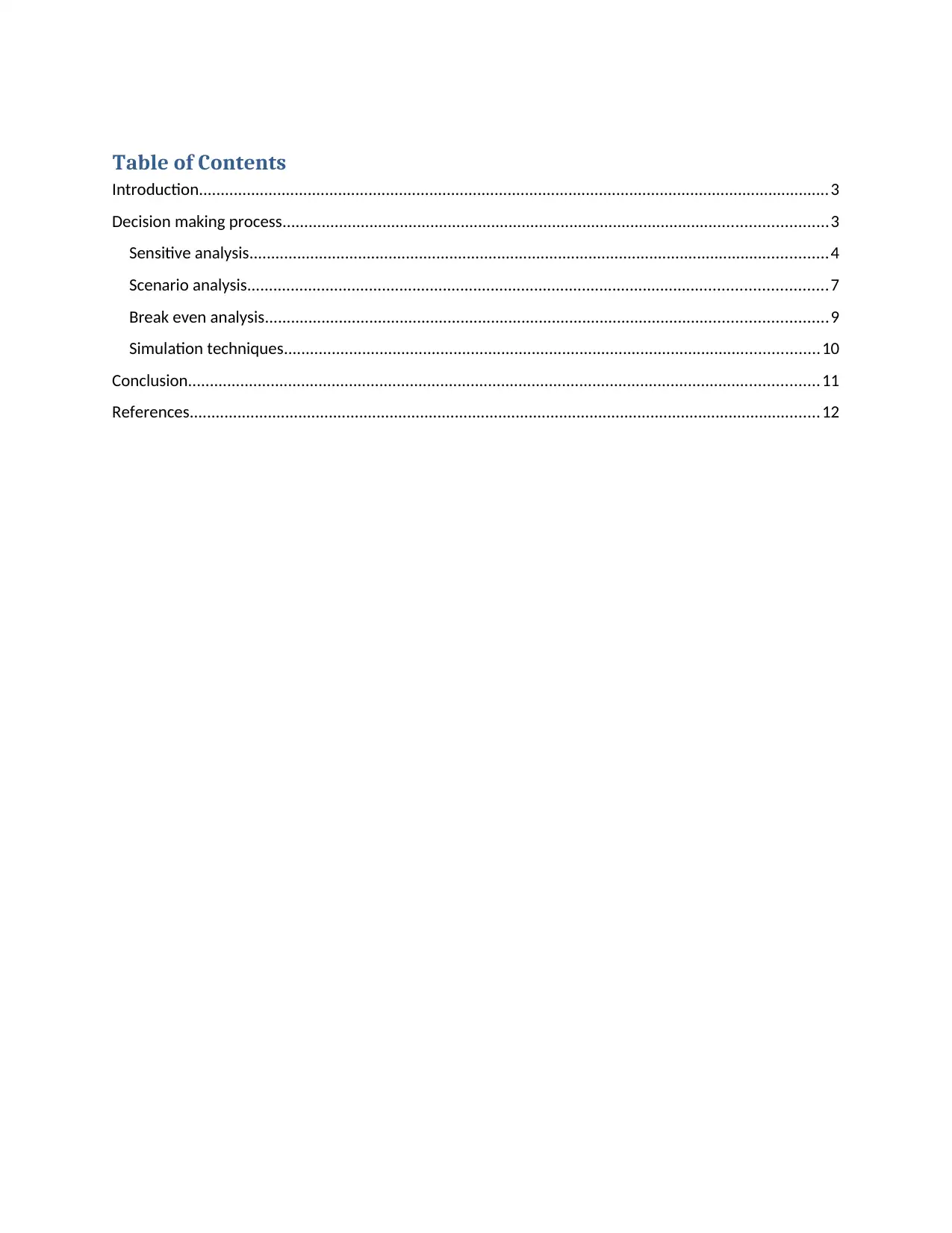
Table of Contents
Introduction.................................................................................................................................................3
Decision making process.............................................................................................................................3
Sensitive analysis.....................................................................................................................................4
Scenario analysis.....................................................................................................................................7
Break even analysis.................................................................................................................................9
Simulation techniques...........................................................................................................................10
Conclusion.................................................................................................................................................11
References.................................................................................................................................................12
Introduction.................................................................................................................................................3
Decision making process.............................................................................................................................3
Sensitive analysis.....................................................................................................................................4
Scenario analysis.....................................................................................................................................7
Break even analysis.................................................................................................................................9
Simulation techniques...........................................................................................................................10
Conclusion.................................................................................................................................................11
References.................................................................................................................................................12
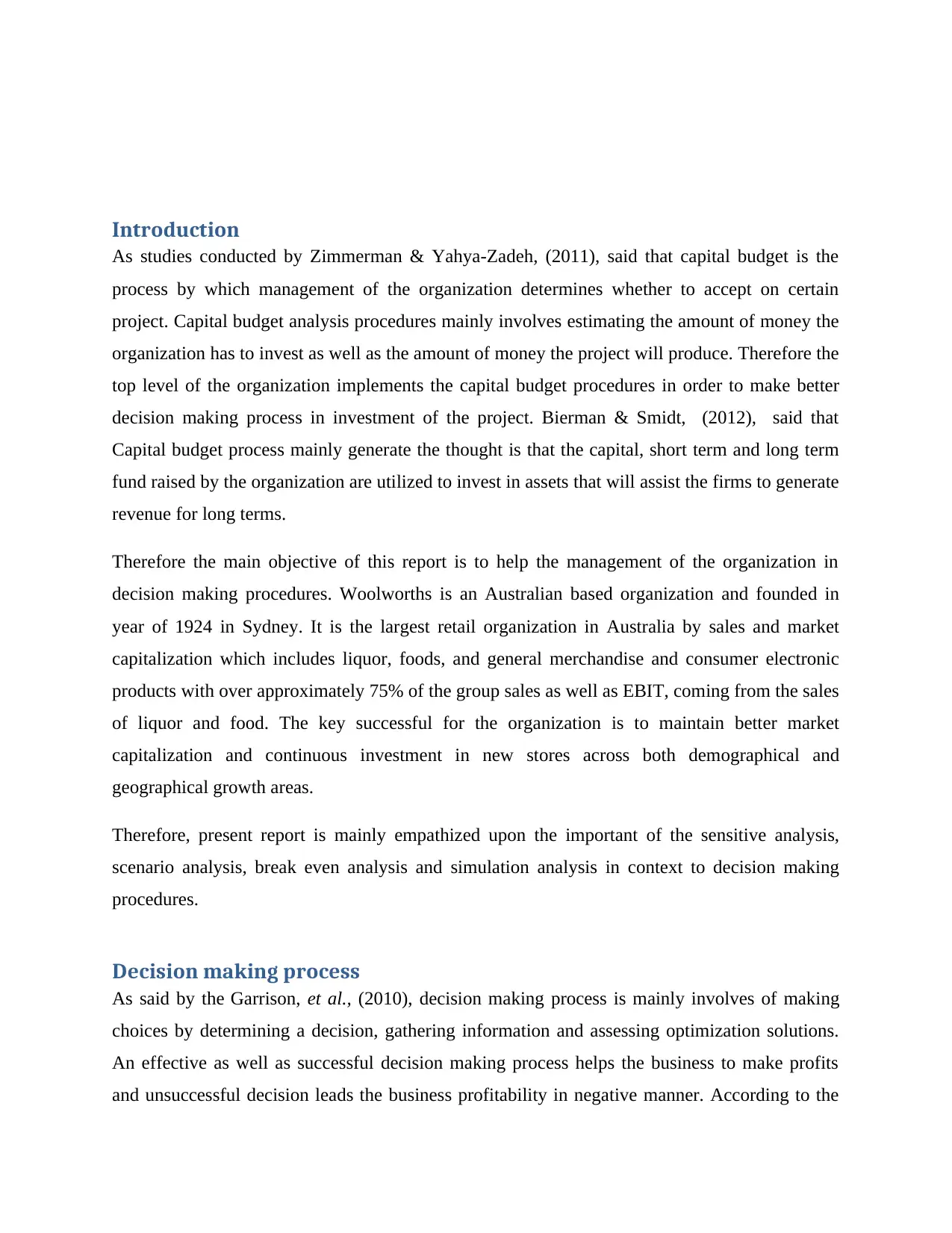
Introduction
As studies conducted by Zimmerman & Yahya-Zadeh, (2011), said that capital budget is the
process by which management of the organization determines whether to accept on certain
project. Capital budget analysis procedures mainly involves estimating the amount of money the
organization has to invest as well as the amount of money the project will produce. Therefore the
top level of the organization implements the capital budget procedures in order to make better
decision making process in investment of the project. Bierman & Smidt, (2012), said that
Capital budget process mainly generate the thought is that the capital, short term and long term
fund raised by the organization are utilized to invest in assets that will assist the firms to generate
revenue for long terms.
Therefore the main objective of this report is to help the management of the organization in
decision making procedures. Woolworths is an Australian based organization and founded in
year of 1924 in Sydney. It is the largest retail organization in Australia by sales and market
capitalization which includes liquor, foods, and general merchandise and consumer electronic
products with over approximately 75% of the group sales as well as EBIT, coming from the sales
of liquor and food. The key successful for the organization is to maintain better market
capitalization and continuous investment in new stores across both demographical and
geographical growth areas.
Therefore, present report is mainly empathized upon the important of the sensitive analysis,
scenario analysis, break even analysis and simulation analysis in context to decision making
procedures.
Decision making process
As said by the Garrison, et al., (2010), decision making process is mainly involves of making
choices by determining a decision, gathering information and assessing optimization solutions.
An effective as well as successful decision making process helps the business to make profits
and unsuccessful decision leads the business profitability in negative manner. According to the
As studies conducted by Zimmerman & Yahya-Zadeh, (2011), said that capital budget is the
process by which management of the organization determines whether to accept on certain
project. Capital budget analysis procedures mainly involves estimating the amount of money the
organization has to invest as well as the amount of money the project will produce. Therefore the
top level of the organization implements the capital budget procedures in order to make better
decision making process in investment of the project. Bierman & Smidt, (2012), said that
Capital budget process mainly generate the thought is that the capital, short term and long term
fund raised by the organization are utilized to invest in assets that will assist the firms to generate
revenue for long terms.
Therefore the main objective of this report is to help the management of the organization in
decision making procedures. Woolworths is an Australian based organization and founded in
year of 1924 in Sydney. It is the largest retail organization in Australia by sales and market
capitalization which includes liquor, foods, and general merchandise and consumer electronic
products with over approximately 75% of the group sales as well as EBIT, coming from the sales
of liquor and food. The key successful for the organization is to maintain better market
capitalization and continuous investment in new stores across both demographical and
geographical growth areas.
Therefore, present report is mainly empathized upon the important of the sensitive analysis,
scenario analysis, break even analysis and simulation analysis in context to decision making
procedures.
Decision making process
As said by the Garrison, et al., (2010), decision making process is mainly involves of making
choices by determining a decision, gathering information and assessing optimization solutions.
An effective as well as successful decision making process helps the business to make profits
and unsuccessful decision leads the business profitability in negative manner. According to the
⊘ This is a preview!⊘
Do you want full access?
Subscribe today to unlock all pages.

Trusted by 1+ million students worldwide
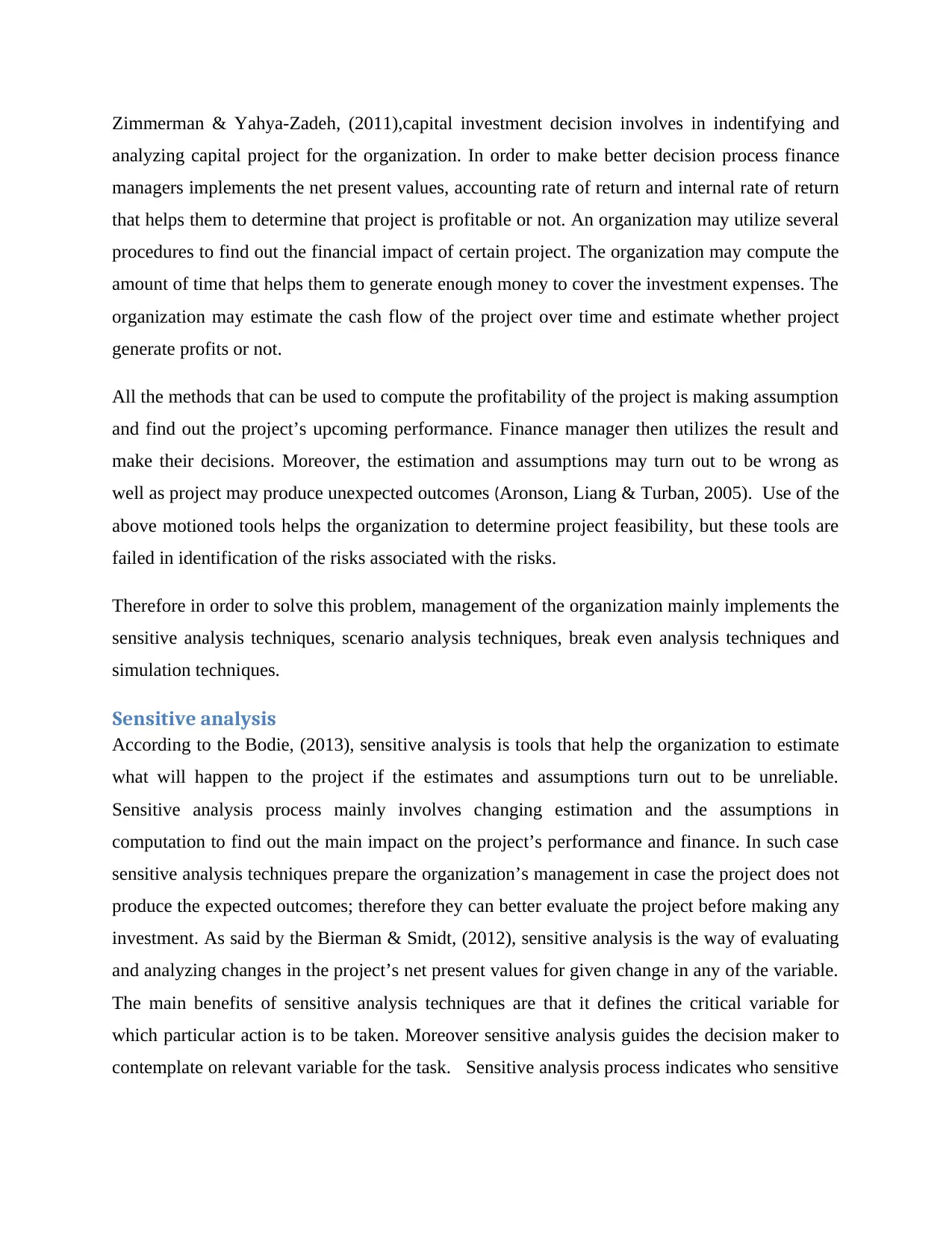
Zimmerman & Yahya-Zadeh, (2011),capital investment decision involves in indentifying and
analyzing capital project for the organization. In order to make better decision process finance
managers implements the net present values, accounting rate of return and internal rate of return
that helps them to determine that project is profitable or not. An organization may utilize several
procedures to find out the financial impact of certain project. The organization may compute the
amount of time that helps them to generate enough money to cover the investment expenses. The
organization may estimate the cash flow of the project over time and estimate whether project
generate profits or not.
All the methods that can be used to compute the profitability of the project is making assumption
and find out the project’s upcoming performance. Finance manager then utilizes the result and
make their decisions. Moreover, the estimation and assumptions may turn out to be wrong as
well as project may produce unexpected outcomes (Aronson, Liang & Turban, 2005). Use of the
above motioned tools helps the organization to determine project feasibility, but these tools are
failed in identification of the risks associated with the risks.
Therefore in order to solve this problem, management of the organization mainly implements the
sensitive analysis techniques, scenario analysis techniques, break even analysis techniques and
simulation techniques.
Sensitive analysis
According to the Bodie, (2013), sensitive analysis is tools that help the organization to estimate
what will happen to the project if the estimates and assumptions turn out to be unreliable.
Sensitive analysis process mainly involves changing estimation and the assumptions in
computation to find out the main impact on the project’s performance and finance. In such case
sensitive analysis techniques prepare the organization’s management in case the project does not
produce the expected outcomes; therefore they can better evaluate the project before making any
investment. As said by the Bierman & Smidt, (2012), sensitive analysis is the way of evaluating
and analyzing changes in the project’s net present values for given change in any of the variable.
The main benefits of sensitive analysis techniques are that it defines the critical variable for
which particular action is to be taken. Moreover sensitive analysis guides the decision maker to
contemplate on relevant variable for the task. Sensitive analysis process indicates who sensitive
analyzing capital project for the organization. In order to make better decision process finance
managers implements the net present values, accounting rate of return and internal rate of return
that helps them to determine that project is profitable or not. An organization may utilize several
procedures to find out the financial impact of certain project. The organization may compute the
amount of time that helps them to generate enough money to cover the investment expenses. The
organization may estimate the cash flow of the project over time and estimate whether project
generate profits or not.
All the methods that can be used to compute the profitability of the project is making assumption
and find out the project’s upcoming performance. Finance manager then utilizes the result and
make their decisions. Moreover, the estimation and assumptions may turn out to be wrong as
well as project may produce unexpected outcomes (Aronson, Liang & Turban, 2005). Use of the
above motioned tools helps the organization to determine project feasibility, but these tools are
failed in identification of the risks associated with the risks.
Therefore in order to solve this problem, management of the organization mainly implements the
sensitive analysis techniques, scenario analysis techniques, break even analysis techniques and
simulation techniques.
Sensitive analysis
According to the Bodie, (2013), sensitive analysis is tools that help the organization to estimate
what will happen to the project if the estimates and assumptions turn out to be unreliable.
Sensitive analysis process mainly involves changing estimation and the assumptions in
computation to find out the main impact on the project’s performance and finance. In such case
sensitive analysis techniques prepare the organization’s management in case the project does not
produce the expected outcomes; therefore they can better evaluate the project before making any
investment. As said by the Bierman & Smidt, (2012), sensitive analysis is the way of evaluating
and analyzing changes in the project’s net present values for given change in any of the variable.
The main benefits of sensitive analysis techniques are that it defines the critical variable for
which particular action is to be taken. Moreover sensitive analysis guides the decision maker to
contemplate on relevant variable for the task. Sensitive analysis process indicates who sensitive
Paraphrase This Document
Need a fresh take? Get an instant paraphrase of this document with our AI Paraphraser
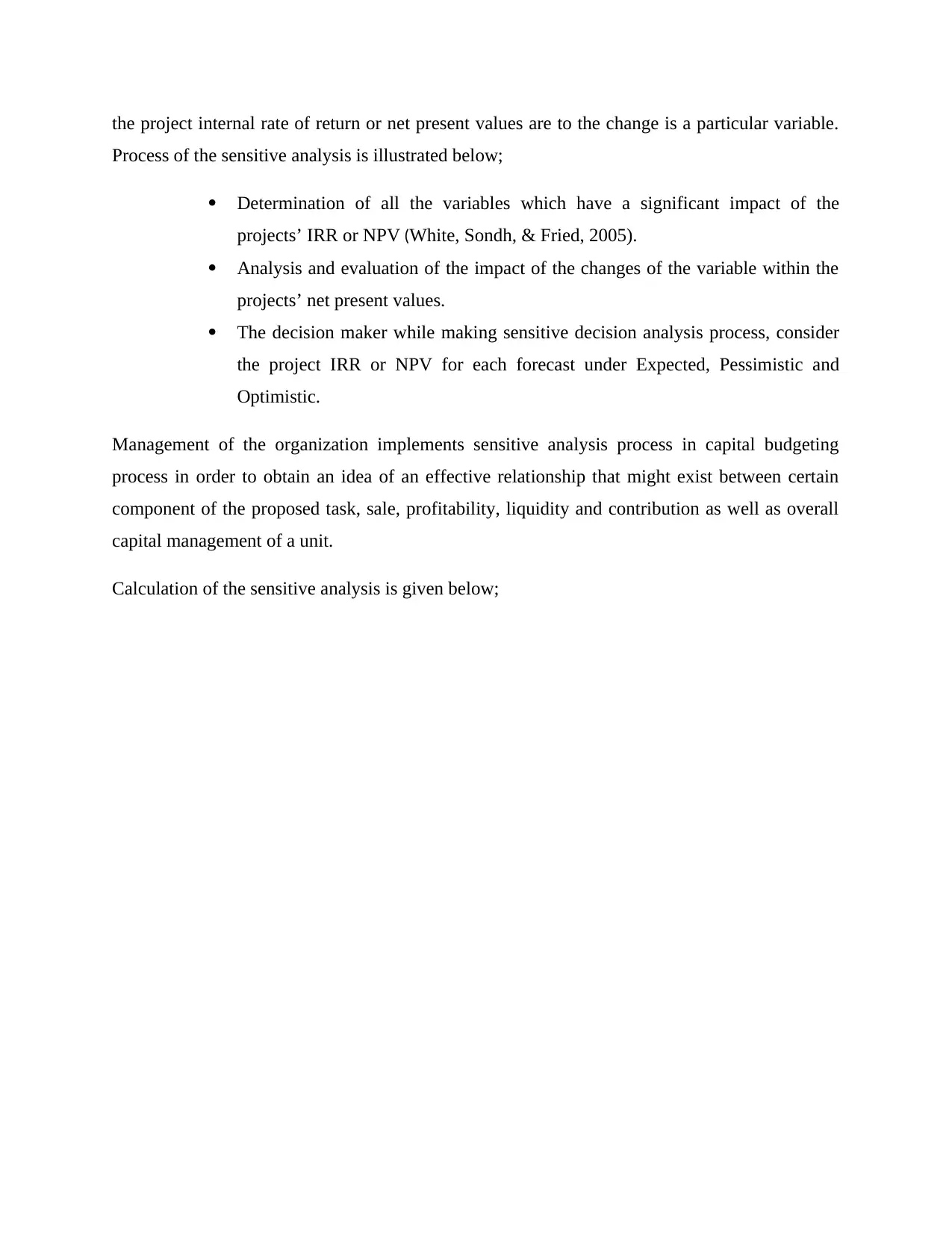
the project internal rate of return or net present values are to the change is a particular variable.
Process of the sensitive analysis is illustrated below;
Determination of all the variables which have a significant impact of the
projects’ IRR or NPV (White, Sondh, & Fried, 2005).
Analysis and evaluation of the impact of the changes of the variable within the
projects’ net present values.
The decision maker while making sensitive decision analysis process, consider
the project IRR or NPV for each forecast under Expected, Pessimistic and
Optimistic.
Management of the organization implements sensitive analysis process in capital budgeting
process in order to obtain an idea of an effective relationship that might exist between certain
component of the proposed task, sale, profitability, liquidity and contribution as well as overall
capital management of a unit.
Calculation of the sensitive analysis is given below;
Process of the sensitive analysis is illustrated below;
Determination of all the variables which have a significant impact of the
projects’ IRR or NPV (White, Sondh, & Fried, 2005).
Analysis and evaluation of the impact of the changes of the variable within the
projects’ net present values.
The decision maker while making sensitive decision analysis process, consider
the project IRR or NPV for each forecast under Expected, Pessimistic and
Optimistic.
Management of the organization implements sensitive analysis process in capital budgeting
process in order to obtain an idea of an effective relationship that might exist between certain
component of the proposed task, sale, profitability, liquidity and contribution as well as overall
capital management of a unit.
Calculation of the sensitive analysis is given below;
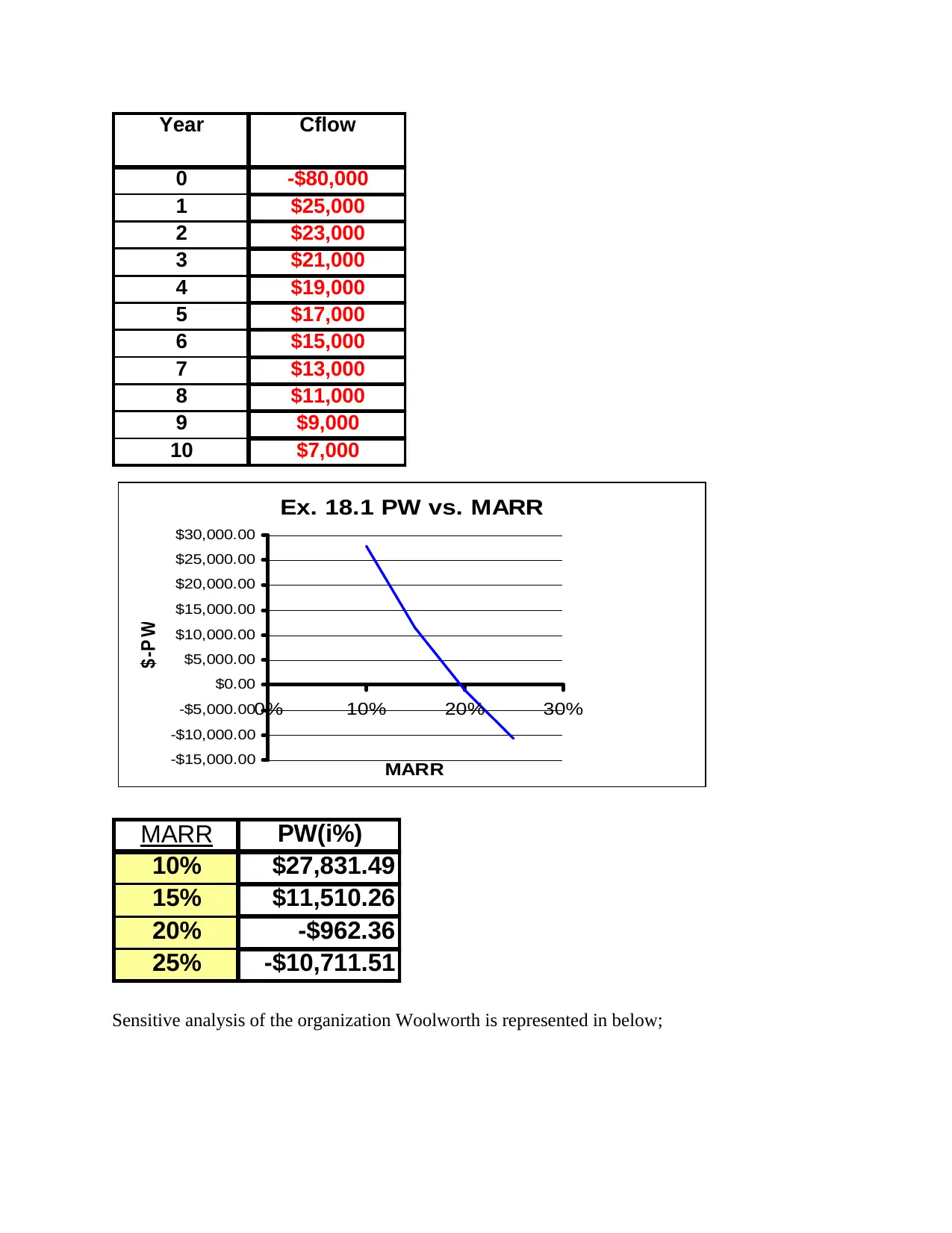
Year Cflow
0 -$80,000
1 $25,000
2 $23,000
3 $21,000
4 $19,000
5 $17,000
6 $15,000
7 $13,000
8 $11,000
9 $9,000
10 $7,000
Ex. 18.1 PW vs. MARR
-$15,000.00
-$10,000.00
-$5,000.00
$0.00
$5,000.00
$10,000.00
$15,000.00
$20,000.00
$25,000.00
$30,000.00
0% 10% 20% 30%
MARR
$-P W
MARR PW(i%)
10% $27,831.49
15% $11,510.26
20% -$962.36
25% -$10,711.51
Sensitive analysis of the organization Woolworth is represented in below;
0 -$80,000
1 $25,000
2 $23,000
3 $21,000
4 $19,000
5 $17,000
6 $15,000
7 $13,000
8 $11,000
9 $9,000
10 $7,000
Ex. 18.1 PW vs. MARR
-$15,000.00
-$10,000.00
-$5,000.00
$0.00
$5,000.00
$10,000.00
$15,000.00
$20,000.00
$25,000.00
$30,000.00
0% 10% 20% 30%
MARR
$-P W
MARR PW(i%)
10% $27,831.49
15% $11,510.26
20% -$962.36
25% -$10,711.51
Sensitive analysis of the organization Woolworth is represented in below;
⊘ This is a preview!⊘
Do you want full access?
Subscribe today to unlock all pages.

Trusted by 1+ million students worldwide
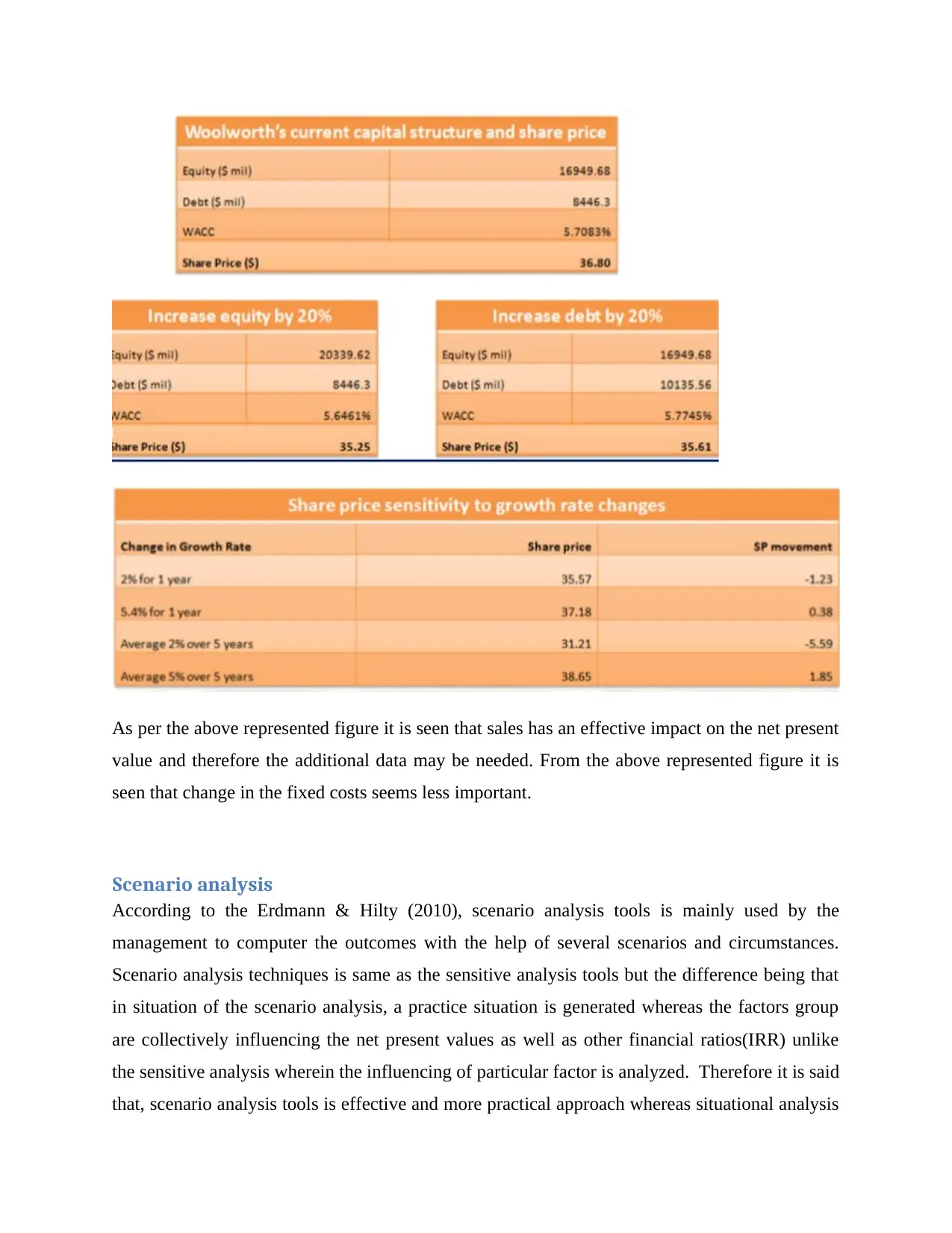
As per the above represented figure it is seen that sales has an effective impact on the net present
value and therefore the additional data may be needed. From the above represented figure it is
seen that change in the fixed costs seems less important.
Scenario analysis
According to the Erdmann & Hilty (2010), scenario analysis tools is mainly used by the
management to computer the outcomes with the help of several scenarios and circumstances.
Scenario analysis techniques is same as the sensitive analysis tools but the difference being that
in situation of the scenario analysis, a practice situation is generated whereas the factors group
are collectively influencing the net present values as well as other financial ratios(IRR) unlike
the sensitive analysis wherein the influencing of particular factor is analyzed. Therefore it is said
that, scenario analysis tools is effective and more practical approach whereas situational analysis
value and therefore the additional data may be needed. From the above represented figure it is
seen that change in the fixed costs seems less important.
Scenario analysis
According to the Erdmann & Hilty (2010), scenario analysis tools is mainly used by the
management to computer the outcomes with the help of several scenarios and circumstances.
Scenario analysis techniques is same as the sensitive analysis tools but the difference being that
in situation of the scenario analysis, a practice situation is generated whereas the factors group
are collectively influencing the net present values as well as other financial ratios(IRR) unlike
the sensitive analysis wherein the influencing of particular factor is analyzed. Therefore it is said
that, scenario analysis tools is effective and more practical approach whereas situational analysis
Paraphrase This Document
Need a fresh take? Get an instant paraphrase of this document with our AI Paraphraser
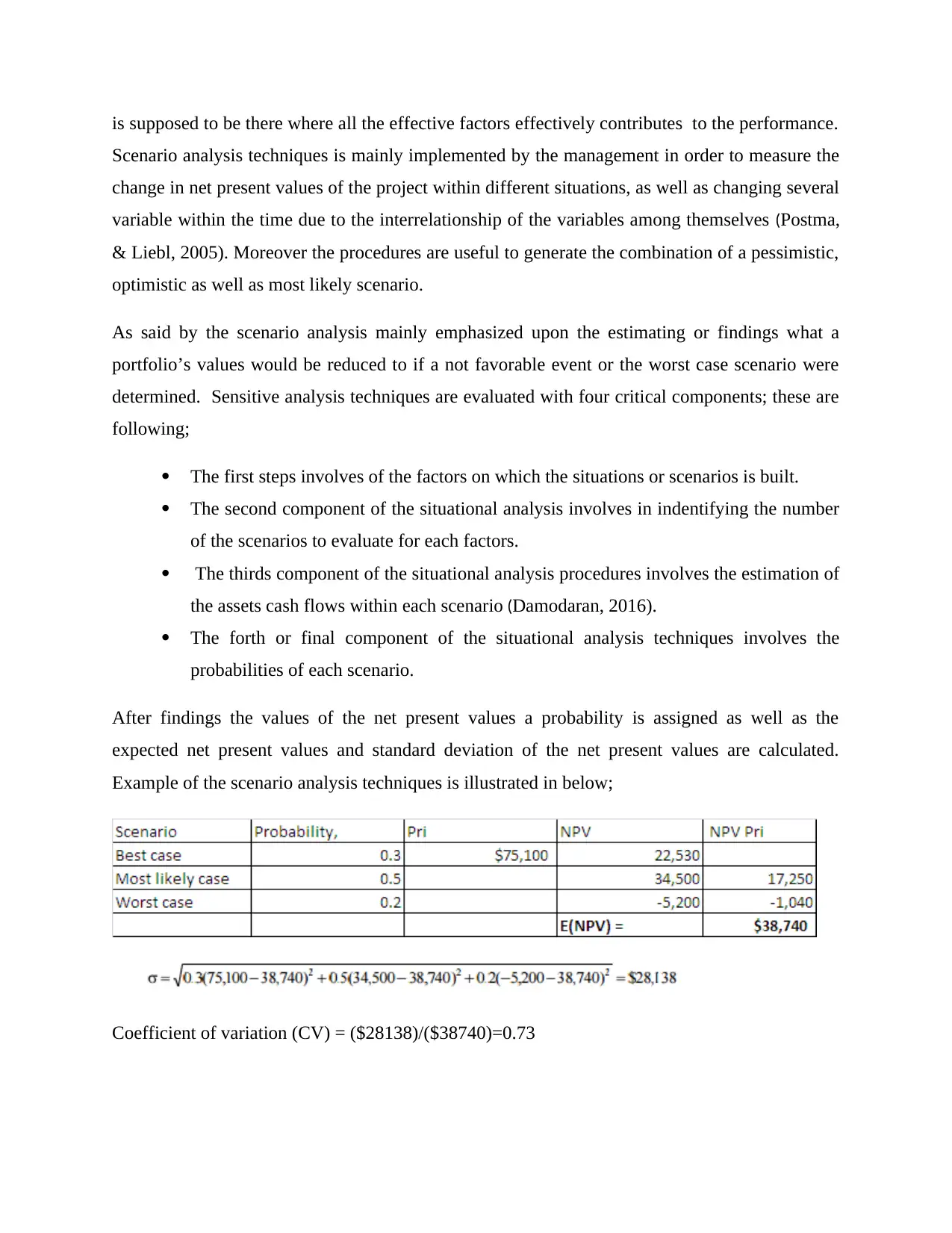
is supposed to be there where all the effective factors effectively contributes to the performance.
Scenario analysis techniques is mainly implemented by the management in order to measure the
change in net present values of the project within different situations, as well as changing several
variable within the time due to the interrelationship of the variables among themselves (Postma,
& Liebl, 2005). Moreover the procedures are useful to generate the combination of a pessimistic,
optimistic as well as most likely scenario.
As said by the scenario analysis mainly emphasized upon the estimating or findings what a
portfolio’s values would be reduced to if a not favorable event or the worst case scenario were
determined. Sensitive analysis techniques are evaluated with four critical components; these are
following;
The first steps involves of the factors on which the situations or scenarios is built.
The second component of the situational analysis involves in indentifying the number
of the scenarios to evaluate for each factors.
The thirds component of the situational analysis procedures involves the estimation of
the assets cash flows within each scenario (Damodaran, 2016).
The forth or final component of the situational analysis techniques involves the
probabilities of each scenario.
After findings the values of the net present values a probability is assigned as well as the
expected net present values and standard deviation of the net present values are calculated.
Example of the scenario analysis techniques is illustrated in below;
Coefficient of variation (CV) = ($28138)/($38740)=0.73
Scenario analysis techniques is mainly implemented by the management in order to measure the
change in net present values of the project within different situations, as well as changing several
variable within the time due to the interrelationship of the variables among themselves (Postma,
& Liebl, 2005). Moreover the procedures are useful to generate the combination of a pessimistic,
optimistic as well as most likely scenario.
As said by the scenario analysis mainly emphasized upon the estimating or findings what a
portfolio’s values would be reduced to if a not favorable event or the worst case scenario were
determined. Sensitive analysis techniques are evaluated with four critical components; these are
following;
The first steps involves of the factors on which the situations or scenarios is built.
The second component of the situational analysis involves in indentifying the number
of the scenarios to evaluate for each factors.
The thirds component of the situational analysis procedures involves the estimation of
the assets cash flows within each scenario (Damodaran, 2016).
The forth or final component of the situational analysis techniques involves the
probabilities of each scenario.
After findings the values of the net present values a probability is assigned as well as the
expected net present values and standard deviation of the net present values are calculated.
Example of the scenario analysis techniques is illustrated in below;
Coefficient of variation (CV) = ($28138)/($38740)=0.73
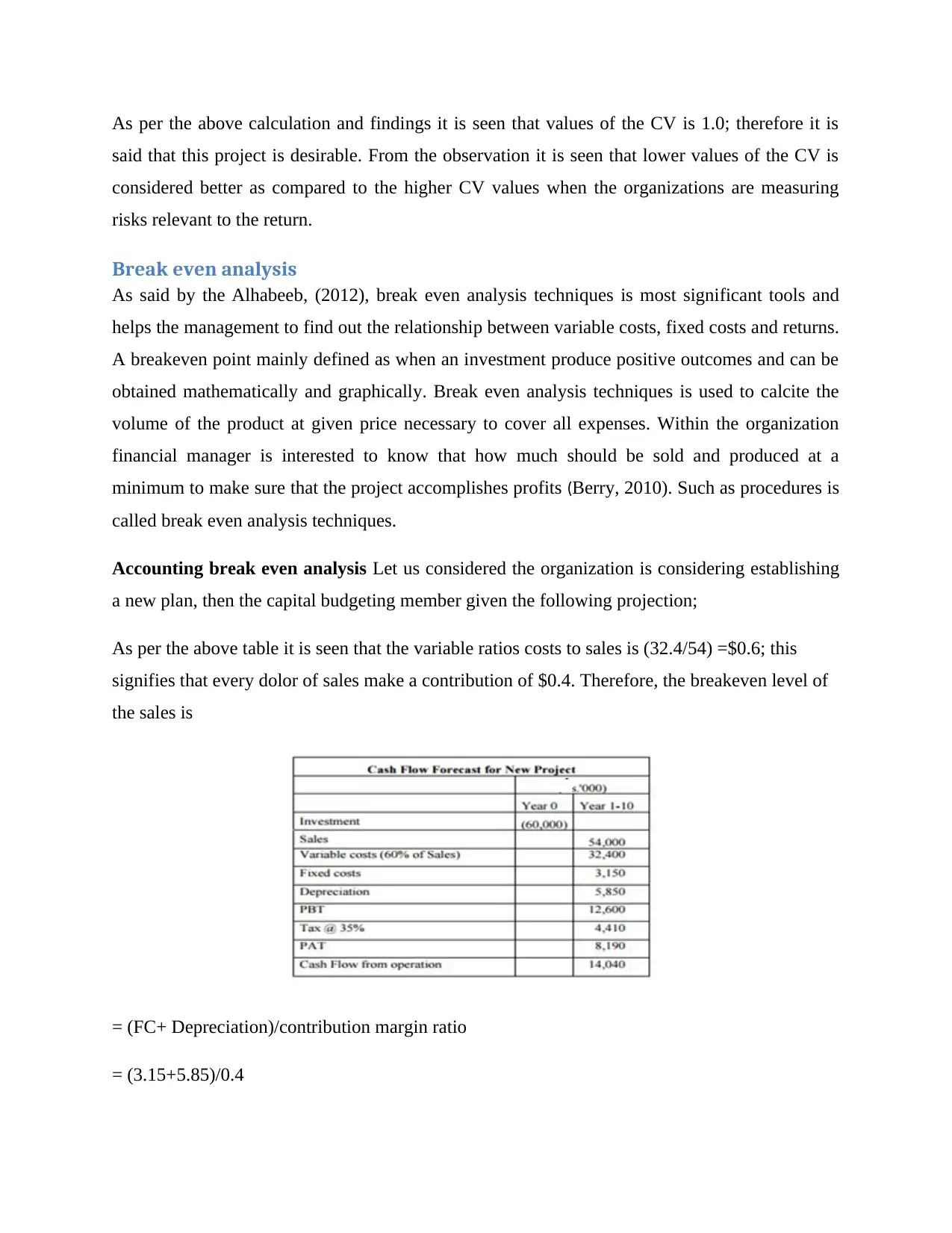
As per the above calculation and findings it is seen that values of the CV is 1.0; therefore it is
said that this project is desirable. From the observation it is seen that lower values of the CV is
considered better as compared to the higher CV values when the organizations are measuring
risks relevant to the return.
Break even analysis
As said by the Alhabeeb, (2012), break even analysis techniques is most significant tools and
helps the management to find out the relationship between variable costs, fixed costs and returns.
A breakeven point mainly defined as when an investment produce positive outcomes and can be
obtained mathematically and graphically. Break even analysis techniques is used to calcite the
volume of the product at given price necessary to cover all expenses. Within the organization
financial manager is interested to know that how much should be sold and produced at a
minimum to make sure that the project accomplishes profits (Berry, 2010). Such as procedures is
called break even analysis techniques.
Accounting break even analysis Let us considered the organization is considering establishing
a new plan, then the capital budgeting member given the following projection;
As per the above table it is seen that the variable ratios costs to sales is (32.4/54) =$0.6; this
signifies that every dolor of sales make a contribution of $0.4. Therefore, the breakeven level of
the sales is
= (FC+ Depreciation)/contribution margin ratio
= (3.15+5.85)/0.4
said that this project is desirable. From the observation it is seen that lower values of the CV is
considered better as compared to the higher CV values when the organizations are measuring
risks relevant to the return.
Break even analysis
As said by the Alhabeeb, (2012), break even analysis techniques is most significant tools and
helps the management to find out the relationship between variable costs, fixed costs and returns.
A breakeven point mainly defined as when an investment produce positive outcomes and can be
obtained mathematically and graphically. Break even analysis techniques is used to calcite the
volume of the product at given price necessary to cover all expenses. Within the organization
financial manager is interested to know that how much should be sold and produced at a
minimum to make sure that the project accomplishes profits (Berry, 2010). Such as procedures is
called break even analysis techniques.
Accounting break even analysis Let us considered the organization is considering establishing
a new plan, then the capital budgeting member given the following projection;
As per the above table it is seen that the variable ratios costs to sales is (32.4/54) =$0.6; this
signifies that every dolor of sales make a contribution of $0.4. Therefore, the breakeven level of
the sales is
= (FC+ Depreciation)/contribution margin ratio
= (3.15+5.85)/0.4
⊘ This is a preview!⊘
Do you want full access?
Subscribe today to unlock all pages.

Trusted by 1+ million students worldwide
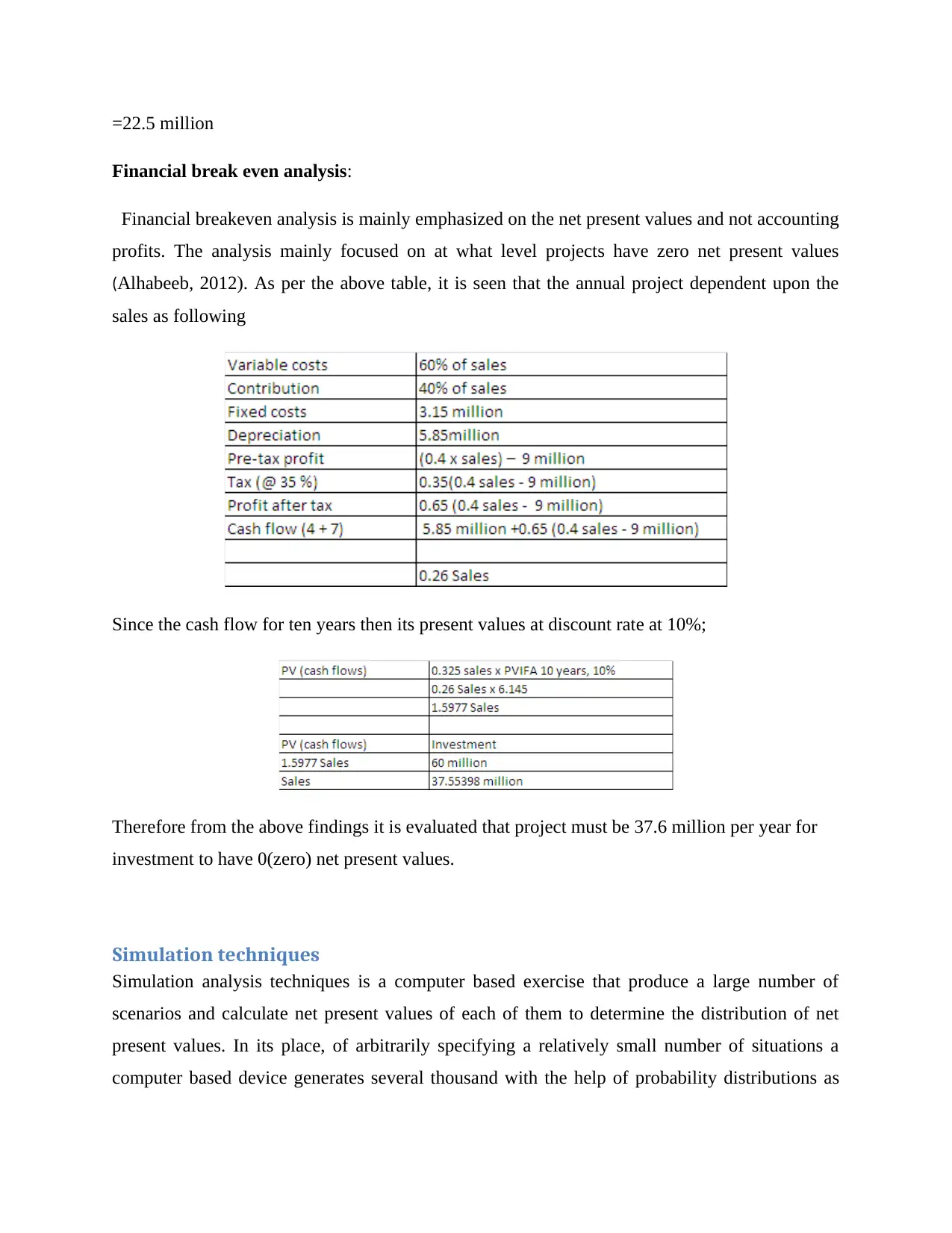
=22.5 million
Financial break even analysis:
Financial breakeven analysis is mainly emphasized on the net present values and not accounting
profits. The analysis mainly focused on at what level projects have zero net present values
(Alhabeeb, 2012). As per the above table, it is seen that the annual project dependent upon the
sales as following
Since the cash flow for ten years then its present values at discount rate at 10%;
Therefore from the above findings it is evaluated that project must be 37.6 million per year for
investment to have 0(zero) net present values.
Simulation techniques
Simulation analysis techniques is a computer based exercise that produce a large number of
scenarios and calculate net present values of each of them to determine the distribution of net
present values. In its place, of arbitrarily specifying a relatively small number of situations a
computer based device generates several thousand with the help of probability distributions as
Financial break even analysis:
Financial breakeven analysis is mainly emphasized on the net present values and not accounting
profits. The analysis mainly focused on at what level projects have zero net present values
(Alhabeeb, 2012). As per the above table, it is seen that the annual project dependent upon the
sales as following
Since the cash flow for ten years then its present values at discount rate at 10%;
Therefore from the above findings it is evaluated that project must be 37.6 million per year for
investment to have 0(zero) net present values.
Simulation techniques
Simulation analysis techniques is a computer based exercise that produce a large number of
scenarios and calculate net present values of each of them to determine the distribution of net
present values. In its place, of arbitrarily specifying a relatively small number of situations a
computer based device generates several thousand with the help of probability distributions as
Paraphrase This Document
Need a fresh take? Get an instant paraphrase of this document with our AI Paraphraser
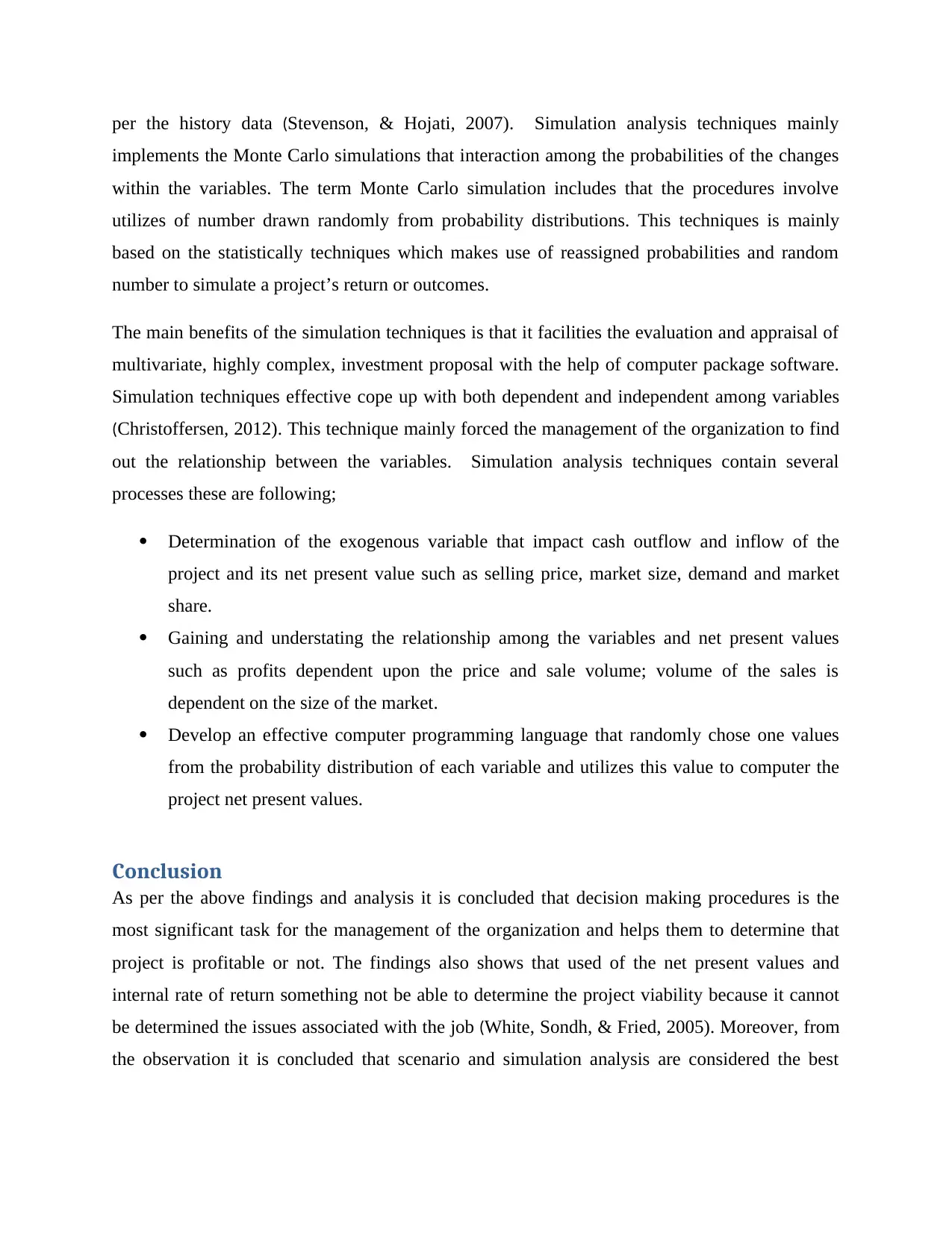
per the history data (Stevenson, & Hojati, 2007). Simulation analysis techniques mainly
implements the Monte Carlo simulations that interaction among the probabilities of the changes
within the variables. The term Monte Carlo simulation includes that the procedures involve
utilizes of number drawn randomly from probability distributions. This techniques is mainly
based on the statistically techniques which makes use of reassigned probabilities and random
number to simulate a project’s return or outcomes.
The main benefits of the simulation techniques is that it facilities the evaluation and appraisal of
multivariate, highly complex, investment proposal with the help of computer package software.
Simulation techniques effective cope up with both dependent and independent among variables
(Christoffersen, 2012). This technique mainly forced the management of the organization to find
out the relationship between the variables. Simulation analysis techniques contain several
processes these are following;
Determination of the exogenous variable that impact cash outflow and inflow of the
project and its net present value such as selling price, market size, demand and market
share.
Gaining and understating the relationship among the variables and net present values
such as profits dependent upon the price and sale volume; volume of the sales is
dependent on the size of the market.
Develop an effective computer programming language that randomly chose one values
from the probability distribution of each variable and utilizes this value to computer the
project net present values.
Conclusion
As per the above findings and analysis it is concluded that decision making procedures is the
most significant task for the management of the organization and helps them to determine that
project is profitable or not. The findings also shows that used of the net present values and
internal rate of return something not be able to determine the project viability because it cannot
be determined the issues associated with the job (White, Sondh, & Fried, 2005). Moreover, from
the observation it is concluded that scenario and simulation analysis are considered the best
implements the Monte Carlo simulations that interaction among the probabilities of the changes
within the variables. The term Monte Carlo simulation includes that the procedures involve
utilizes of number drawn randomly from probability distributions. This techniques is mainly
based on the statistically techniques which makes use of reassigned probabilities and random
number to simulate a project’s return or outcomes.
The main benefits of the simulation techniques is that it facilities the evaluation and appraisal of
multivariate, highly complex, investment proposal with the help of computer package software.
Simulation techniques effective cope up with both dependent and independent among variables
(Christoffersen, 2012). This technique mainly forced the management of the organization to find
out the relationship between the variables. Simulation analysis techniques contain several
processes these are following;
Determination of the exogenous variable that impact cash outflow and inflow of the
project and its net present value such as selling price, market size, demand and market
share.
Gaining and understating the relationship among the variables and net present values
such as profits dependent upon the price and sale volume; volume of the sales is
dependent on the size of the market.
Develop an effective computer programming language that randomly chose one values
from the probability distribution of each variable and utilizes this value to computer the
project net present values.
Conclusion
As per the above findings and analysis it is concluded that decision making procedures is the
most significant task for the management of the organization and helps them to determine that
project is profitable or not. The findings also shows that used of the net present values and
internal rate of return something not be able to determine the project viability because it cannot
be determined the issues associated with the job (White, Sondh, & Fried, 2005). Moreover, from
the observation it is concluded that scenario and simulation analysis are considered the best
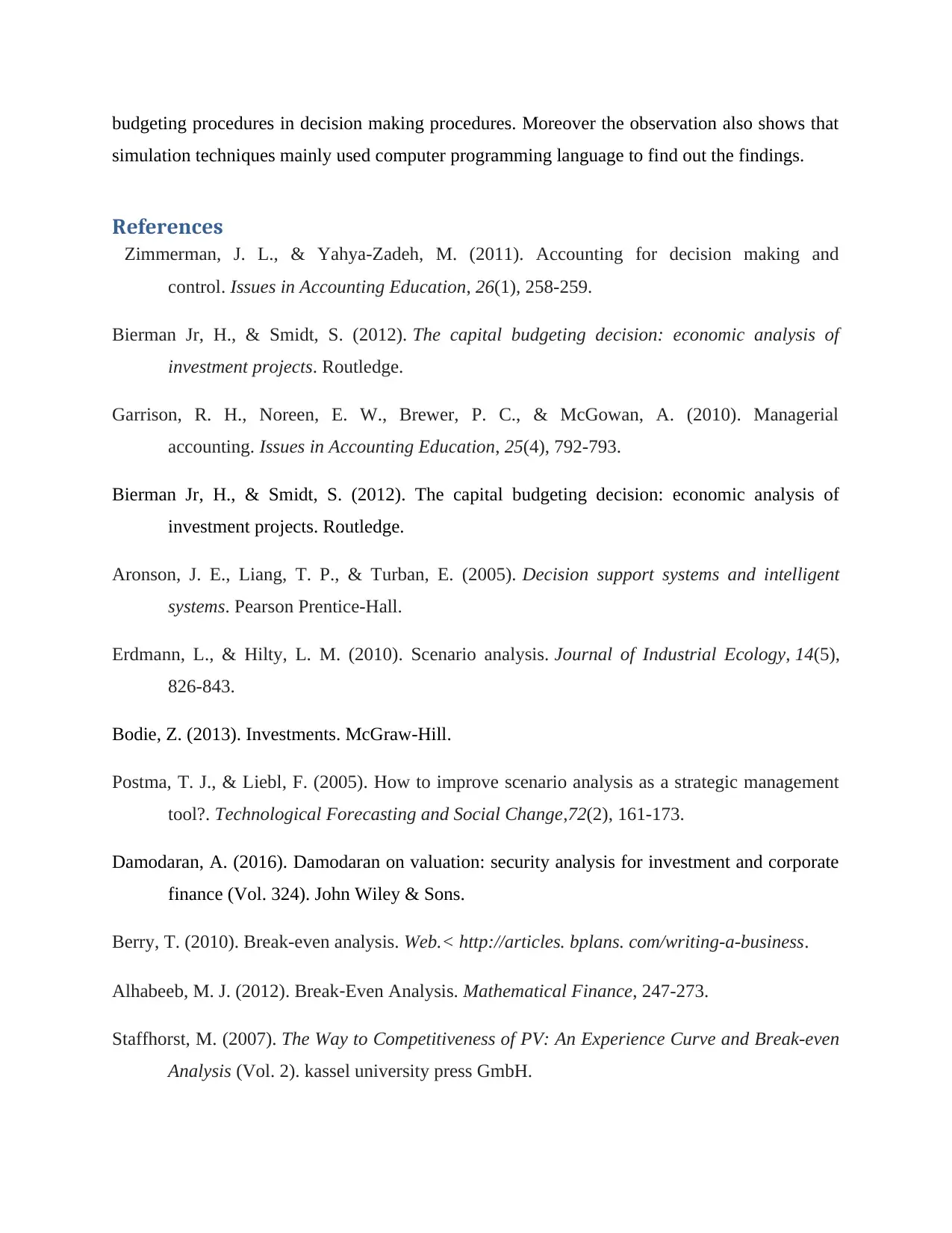
budgeting procedures in decision making procedures. Moreover the observation also shows that
simulation techniques mainly used computer programming language to find out the findings.
References
Zimmerman, J. L., & Yahya-Zadeh, M. (2011). Accounting for decision making and
control. Issues in Accounting Education, 26(1), 258-259.
Bierman Jr, H., & Smidt, S. (2012). The capital budgeting decision: economic analysis of
investment projects. Routledge.
Garrison, R. H., Noreen, E. W., Brewer, P. C., & McGowan, A. (2010). Managerial
accounting. Issues in Accounting Education, 25(4), 792-793.
Bierman Jr, H., & Smidt, S. (2012). The capital budgeting decision: economic analysis of
investment projects. Routledge.
Aronson, J. E., Liang, T. P., & Turban, E. (2005). Decision support systems and intelligent
systems. Pearson Prentice-Hall.
Erdmann, L., & Hilty, L. M. (2010). Scenario analysis. Journal of Industrial Ecology, 14(5),
826-843.
Bodie, Z. (2013). Investments. McGraw-Hill.
Postma, T. J., & Liebl, F. (2005). How to improve scenario analysis as a strategic management
tool?. Technological Forecasting and Social Change,72(2), 161-173.
Damodaran, A. (2016). Damodaran on valuation: security analysis for investment and corporate
finance (Vol. 324). John Wiley & Sons.
Berry, T. (2010). Break-even analysis. Web.< http://articles. bplans. com/writing-a-business.
Alhabeeb, M. J. (2012). Break‐Even Analysis. Mathematical Finance, 247-273.
Staffhorst, M. (2007). The Way to Competitiveness of PV: An Experience Curve and Break-even
Analysis (Vol. 2). kassel university press GmbH.
simulation techniques mainly used computer programming language to find out the findings.
References
Zimmerman, J. L., & Yahya-Zadeh, M. (2011). Accounting for decision making and
control. Issues in Accounting Education, 26(1), 258-259.
Bierman Jr, H., & Smidt, S. (2012). The capital budgeting decision: economic analysis of
investment projects. Routledge.
Garrison, R. H., Noreen, E. W., Brewer, P. C., & McGowan, A. (2010). Managerial
accounting. Issues in Accounting Education, 25(4), 792-793.
Bierman Jr, H., & Smidt, S. (2012). The capital budgeting decision: economic analysis of
investment projects. Routledge.
Aronson, J. E., Liang, T. P., & Turban, E. (2005). Decision support systems and intelligent
systems. Pearson Prentice-Hall.
Erdmann, L., & Hilty, L. M. (2010). Scenario analysis. Journal of Industrial Ecology, 14(5),
826-843.
Bodie, Z. (2013). Investments. McGraw-Hill.
Postma, T. J., & Liebl, F. (2005). How to improve scenario analysis as a strategic management
tool?. Technological Forecasting and Social Change,72(2), 161-173.
Damodaran, A. (2016). Damodaran on valuation: security analysis for investment and corporate
finance (Vol. 324). John Wiley & Sons.
Berry, T. (2010). Break-even analysis. Web.< http://articles. bplans. com/writing-a-business.
Alhabeeb, M. J. (2012). Break‐Even Analysis. Mathematical Finance, 247-273.
Staffhorst, M. (2007). The Way to Competitiveness of PV: An Experience Curve and Break-even
Analysis (Vol. 2). kassel university press GmbH.
⊘ This is a preview!⊘
Do you want full access?
Subscribe today to unlock all pages.

Trusted by 1+ million students worldwide
1 out of 13
Related Documents
Your All-in-One AI-Powered Toolkit for Academic Success.
+13062052269
info@desklib.com
Available 24*7 on WhatsApp / Email
![[object Object]](/_next/static/media/star-bottom.7253800d.svg)
Unlock your academic potential
Copyright © 2020–2025 A2Z Services. All Rights Reserved. Developed and managed by ZUCOL.





